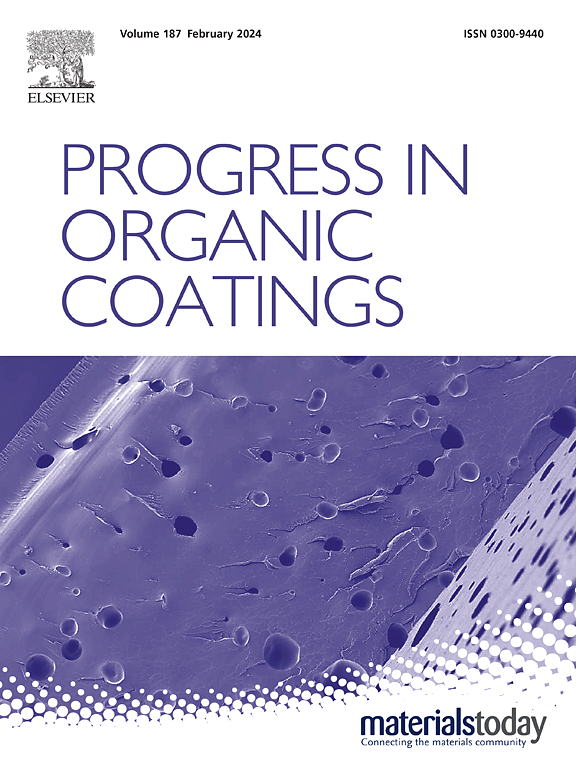定制具有防腐性能的环氧聚氨酯自愈涂层
IF 7.3
2区 材料科学
Q1 CHEMISTRY, APPLIED
引用次数: 0
摘要
海洋腐蚀是对世界海洋基础设施的严重威胁。虽然传统环氧涂料广泛用于防腐,但其固有的脆性、微裂纹扩展和有限的自愈能力仍然是未解决的挑战。为了解决这些问题,本研究提出了一种整合活性稀释剂(1,4-丁二醇二甘油酯醚)、氢键和柔性聚氨酯(PU)段的协同策略,以开发一种先进的自修复混合树脂。分子结构筛选表明,增加环氧当量(EEW)通过促进链迁移直接提高了自愈效率。系统地研究了不同环氧当量的环氧树脂,证明了其在平衡交联密度、力学性能和玻璃化转变温度方面的关键作用。关键是,一种新型聚脲预聚物被合成并加入到环氧基中形成半互穿聚合物网络(semi-IPN),同时实现增韧和增强自愈。通过FT-IR光谱、共聚焦激光扫描显微镜(CLSM)、3D轮廓术和电化学测试等综合表征,证实了混合树脂的结构完整性、形貌和性能。优化后的材料具有优异的机械强度,较高的耐腐蚀性(|Z|0.01Hz >;109 Ω·cm2),自愈效率显著(60℃热活化6 h后回收率达90%)。这项工作为船用多功能环氧涂料的设计提供了一种革命性的方法,弥合了耐久性和适应性保护之间的差距。本文章由计算机程序翻译,如有差异,请以英文原文为准。
Tailoring an epoxy-polyurethane self-healing coating for anticorrosion performance
Marine corrosion is a critical threat to the world's maritime infrastructure. While conventional epoxy coatings are widely used for corrosion protection, their inherent brittleness, microcrack propagation and limited self-healing capabilities remain unresolved challenges. To address these issues, this study proposes a synergistic strategy integrating reactive diluents (1,4-butanediol diglyceryl ether), hydrogen bond and flexible polyurethane (PU) segments to develop an advanced self-healing hybrid resin. Molecular structure screening revealed that increased epoxy equivalent weight (EEW) directly improved self-healing efficiency by facilitating chain mobility. Systematic investigation of the epoxy resins with different epoxy equivalents have demonstrated its critical role in balancing crosslink density, mechanical properties and glass transition temperature. Crucially, a novel polyurea prepolymer was synthesized and incorporated into the epoxy matrix to form a semi-interpenetrating polymer network (semi-IPN), achieving simultaneous toughening and enhanced self-healing. Comprehensive characterization using FT-IR spectroscopy, confocal laser scanning microscopy (CLSM), 3D profilometry and electrochemical tests confirmed the structural integrity, morphology and performance of the hybrid resin. The optimized material exhibited exceptional mechanical strength, high corrosion resistance (|Z|0.01Hz > 109 Ω·cm2), and remarkable self-healing efficiency (>90 % recovery after thermal activation at 60 °C for 6 h). This work provides a transformative approach to the design of multifunctional epoxy coatings for marine applications, bridging the gap between durability and adaptive protection.
求助全文
通过发布文献求助,成功后即可免费获取论文全文。
去求助
来源期刊

Progress in Organic Coatings
工程技术-材料科学:膜
CiteScore
11.40
自引率
15.20%
发文量
577
审稿时长
48 days
期刊介绍:
The aim of this international journal is to analyse and publicise the progress and current state of knowledge in the field of organic coatings and related materials. The Editors and the Editorial Board members will solicit both review and research papers from academic and industrial scientists who are actively engaged in research and development or, in the case of review papers, have extensive experience in the subject to be reviewed. Unsolicited manuscripts will be accepted if they meet the journal''s requirements. The journal publishes papers dealing with such subjects as:
• Chemical, physical and technological properties of organic coatings and related materials
• Problems and methods of preparation, manufacture and application of these materials
• Performance, testing and analysis.
 求助内容:
求助内容: 应助结果提醒方式:
应助结果提醒方式:


